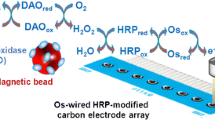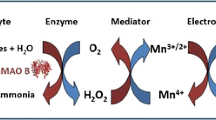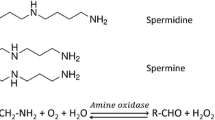Abstract
A selective and sensitive method is presented for biogenic amines (BA) determination. The novelty consists in coupling a highly selective electrochemical biosensor to a weak acid cation-exchange column for online detection of amines. A bienzyme design, based on a recently isolated amine oxidase from grass pea and commercial horseradish peroxidase, was used for the biosensor construction. The enzymes were co-immobilized on the surface of a graphite electrode together with the electrochemical mediator (Os-redox polymer). The electrochemical detection was performed at a low applied potential (−50 mV vs. Ag/AgCl, KCl0.1 M), where biases from interferences are minimal. The separation and determination of six BA, with relevance in food analysis (tyramine, putrescine, cadaverine, histamine, agmatine and spermidine), were investigated. Irrespective of the BA nature, the amine oxidase-based biosensor showed a linear response up to 5 mM, and its sensitivity decreases in the following order: cadaverine, putrescine, spermidine, agmatine, histamine and tyramine. The approach was used to estimate the BA content in fish samples, after their extraction with methanesulfonic acid.





Similar content being viewed by others
References
Silla Santos MH (1996) Biogenic amines: their importance in foods. Int J Food Microbiol 29:213
Shalaby AR (1996) Significance of biogenic amines to food safety and human health. Food Res Int 29:675
Veciana-Nogues MT, Marine-Font A, Vidal-Carou MC (1997) Biogenic amines as hygienic quality indicators of tuna. Relationships with microbial counts, ATP-related compounds, volatile amines, and organoleptic changes. J Agri Food Chem 45:2036
Lehane L, Olley J (2000) Histamine fish poisoning revisited. Int J Food Microbiol 58:1
Tsai Y-H, Lin C-Y, Chang S-C, Chen H-C, Kung H-F, Wei C-I, Hwang D-F (2005) Occurrence of histamine and histamine-forming bacteria in salted mackerel in Taiwan. Food Microbiol 22:461
Pastore P, Favaro G, Badocco D, Tapparo A, Cavalli S, Saccani G (2005) Determination of biogenic amines in chocolate by ion chromatographic separation and pulsed integrated amperometric detection with implemented wave-form at Au disposable electrode. J Chromatogr A 1098:111
Halasz A, Barath A, Simon-Sarkadi L, Holzapfel W (1994) Biogenic amines and their production by microorganisms in food. Trends Food Sci Techol 5:42
McCabe-Sellers BJ, Staggs CG, Bogle ML (2006) Tyramine in foods and monoamine oxidase inhibitor drugs: a crossroad where medicine, nutrition, pharmacy, and food industry converge. J Food Comp Anal 19:S58
Bardocz S (1995) Polyamines in food and their consequences for food quality and human health. Trends Food Sci Technol 6:341
Bardocz S, Grant G, Brown DS, Ralph A, Pusztai A (1993) Polyamines in food-implications for growth and health. J Nutr Biochem 4:66
Onal A (2007) A review: current analytical methods for the determination of biogenic amines in foods. Food Chem 103:1475
Venugopal V (2002) Biosensors in fish production and quality control. Biosens Bioelectron 17:147
Draisci R, Volpe G, Lucentini L, Cecilia A, Federico R, Palleschi G (1998) Determination of biogenic amines with an electrochemical biosensor and its application to salted anchovies. Food Chem 62:225
Ruiz-Jimenez J, Luque de Castro MD (2006) Pervaporation as interface between solid samples and capillary electrophoresis. J Chromatogr A 1110:245
Alberto MR, Arena ME, Manca de Nadra MC (2002) A comparative survey of two analytical methods for identification and quantification of biogenic amines. Food Control 13:125
Hwang D-F, Chang S-H, Shiua C-Y, Chai T-J (1997) High-performance liquid chromatographic determination of biogenic amines in fish implicated in food poisoning. J Chromatogr B 693:23
mo Dugo G, Vilasi F, La Torre GL, Pellicano TM (2006) Reverse phase HPLC/DAD determination of biogenic amines as dansyl derivatives in experimental red wines. Food Chem 95:672
Shakila RJ, Vasundhara TS, Kumudavally KV (2001) A comparison of the TLC-densitometry and HPLC method for the determination of biogenic amines in fish and fishery products. Food Chem 75:255
Cinquina AL, Cali A, Longo F, De Santis L, Severoni A, Abballe F (2004) Determination of biogenic amines in fish tissues by ion-exchange chromatography with conductivity detection. J Chromatogr A 1032:73
Rey M, Pohl C (2003) Novel cation-exchange column for the separation of hydrophobic and/or polyvalent amines. J Chromatogr A 997:199
Saccani G, Tanzi E, Pastore P, Cavalli S, Rey M (2005) Determination of biogenic amines in fresh and processed meat by suppressed ion chromatography-mass spectrometry using a cation-exchange column. J Chromatogr A 1082:43
Casella IG, Gatta M, Desimoni E (2001) Determination of histamine by high-pH anion-exchange chromatography with electrochemical detection. Food Chem 73:367
Innocente N, Biasutti M, Padovese M, Moret S (2007) Determination of biogenic amines in cheese using HPLC technique and direct derivatization of acid extract. Food Chem 101:1285
Li J-S, Wang H, Huang K-J, Zhang H-S (2006) Determination of biogenic amines in apples and wine with 8-phenyl-(4-oxy-acetic acid N-hydroxysuccinimide ester)-4,4-difluoro-1,3,5,7-tetramethyl-4-bora-3a,4a-diaza-s-indacene by high performance liquid chromatography. Anal Chim Acta 575:255
Marks (Rupp) HS, Anderson CR (2005) Determination of putrescine and cadaverine in seafood (fin fish and shellfish) by liquid chromatography using pyrene excimer fluorescence. J Chromatogr A 1094:60
De Borba BM, Rohrer JS (2007) Determination of biogenic amines in alcoholic beverages by ion chromatography with suppressed conductivity detection and integrated pulsed amperometric detection. J Chromatogr A 1155:1122
Favaro G, Pastore P, Saccani G, Cavalli S (2007) Determination of biogenic amines in fresh and processed meat by ion chromatography and integrated pulsed amperometric detection on Au electrode. Food Chem 105:1652
Šebela M, Luhová L, Frébort I, Faulhammer HG, Hirota S, Zajoncová L, Stužka V, Peč P (1998) Analysis of the active sites of copper/topa quinone-containing amine oxidases from Lathyrus odoratus and L. sativus seedlings. Phytochem Anal 9:211
Ohara TJ, Rajagopalan R, Heller A (1994) “Wired” enzyme electrodes for amperometric determination of glucose or lactate in the presence of interfering substances. Anal Chem 66:2451
Niculescu M, Nistor C, Frébort I, Peč P, Mattiasson B, Csöregi E (2000) Redox hydrogel-based amperometric bienzyme electrodes for fish freshness monitoring. Anal Chem 72:1591
Keunchkarian S, Reta M, Romero L, Castells C (2006) Effect of sample solvent on the chromatographic peak shape of analytes eluted under reversed-phase liquid chromatogaphic conditions. J Chromatogr A 1119:20
Palmer T (1985) Understanding enzymes, 2nd edn. Ellis Horwood, Chichester, p 75
Skoog DA, Leary JJ (1992) Principles of instrumental analysis, 4th edn. Saunders College, USA, p 592
Tsai Y-H, Hsieh H-S, Chen H-C, Cheng S-H, Chai T-J, Hwang D-F (2007) Histamine level and species identification of billfish meats implicated in two food-borne poisonings. Food Chem 104:1366
Acknowledgements
Romanian National Council of Research in Universities (research grant TD 5/267-2007, L.M.) and Ministry of Education, Youth and Sport of the Czech Republic (research grant MSM619859216, I.F.) are gratefully acknowledged for financial support.
Author information
Authors and Affiliations
Corresponding author
Electronic supplementary material
Below is the link to the electronic supplementary material
ESM 1
(DOC 40.5 kb)
Rights and permissions
About this article
Cite this article
Mureşan, L., Ronda Valera, R., Frébort, I. et al. Amine oxidase amperometric biosensor coupled to liquid chromatography for biogenic amines determination. Microchim Acta 163, 219–225 (2008). https://doi.org/10.1007/s00604-008-0033-2
Received:
Accepted:
Published:
Issue Date:
DOI: https://doi.org/10.1007/s00604-008-0033-2




